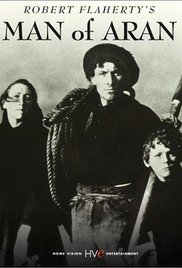Man of Aran **** (1934, Colman ‘Tiger’ King, Maggie Dirrane, Michael Dirrane) – Classic Movie Review 5720
Writer/ cinematographer/ director Robert J Flaherty’s notable 1934 documentary feature film of life on the Isle of Aran in North Ayrshire features the real fishermen and crofter people, and shows their various struggles to live.
(By the way, the Isle of Aran is the largest island in the Firth of Clyde and the seventh largest Scottish island.)
It won the Mussolini Cup for Best Foreign Film at the Venice Film Festival in 1934. Winning the Mussolini Cup seems a bit awkward now, but Mussolini was a big film fan, incidentally.
Colman ‘Tiger’ King is the main character as the Man of Aran, while Maggie Dirrane is his wife and Michael Dirrane plays their son.
Mixing documentary and fictional narrative, pioneering film-maker Flaherty bathes it all in a romantic glow, occasional fudging the truth for effect, but he brings back wonderful pictures from the Isle of Aran. For example, the islanders are seen hunting a basking shark for its oil but that hadn’t happened in generations and n Inuit hunter was hired to show them how to do it.
Produced by Michael Balcon at Gainsborough Pictures studios, it is a brave, bona fide British cinema landmark, though it is hard to imagine a British film company investing in this today.
Also in the cast are Pat Mullin, Patch Ruadh, Pat Flaherty, Tommy O’Rourke, Stephen Dirrane and Pat McDonough.
It runs 75 minutes, was released by Gaumont and Rank, is written by Robert J Flaherty, Frances Flaherty and John Goldman, is shot in black and white by Robert J Flaherty and scored by John Greenwood.
Martin McDonagh’s play The Cripple of Inishmaan is a fictionalised account of the making of this film.
In Italy, Luchino Visconti responded with a similar La Terra Trema (1948) about fishermen’s lives on Sicily.
© Derek Winnert 2017 Classic Movie Review 5720
Check out more reviews on http://derekwinnert.com



